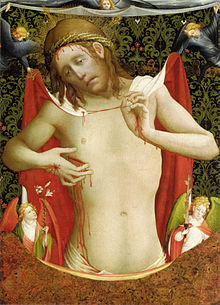
Back Schmeaz'nsmau BAR Schmerzensmann German Varón de dolores Spanish Kipujen mies Finnish Homme de douleurs French Man fan Smerten Frisian Orang yang penuh kesengsaraan ID Imago Pietatis Italian Man van Smarten Dutch Chrystus Boleściwy Polish


Man of Sorrows, a biblical term, is paramount among the prefigurations of the Messiah identified by the Bible in the passages of Isaiah 53 (Servant songs) in the Hebrew Bible. It is also an iconic devotional image that shows Christ, usually naked above the waist, with the wounds of his Passion prominently displayed on his hands and side (the "ostentatio vulnerum", a feature of other standard types of image), often crowned with the Crown of Thorns and sometimes attended by angels. It developed in Europe from the 13th century and was especially popular in Northern Europe.
The image continued to spread and develop iconographical complexity until well after the Renaissance, but the Man of Sorrows in its many artistic forms is the most precise visual expression of the piety of the later Middle Ages, which took its character from mystical contemplation rather than from theological speculation.[1] Together with the Pietà, it was the most popular of the Andachtsbilder-type images of the period – devotional images detached from the narrative of Christ's Passion, intended for meditation.
The Latin term Christus dolens ("suffering Christ") is sometimes used for this depiction. The Pensive Christ is a similar depiction, and the usual composition of the Mass of Saint Gregory includes a vision of the Man of Sorrows.
- ^ Schiller, quote from p. 198, figs. 681–812